64 Search Results for descriptive
January 3, 2019
by Carole Zangari -
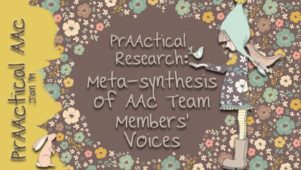
We are delighted to start off the New Year by welcoming back Dr. Kathy Howery for another wonderful review of an AAC research article. Dr. Howery has worked in the field of assistive technology and special education for over three decades. Her research uses phenomenological methods to seek understanding of the lived experience of speaking with/through a speech-generating device. She is currently on contract with the Ministry of Education low incidence team, and as a consultant to schools and school districts across Alberta focusing primarily on children and youth with complex communication needs. In today’s post, she discusses a research study that sheds light on the ways that we can better support students with AAC needs. :::::::::::::::::::::::::::::::::::::::::::::::::::::::::::::::::::::::::::::::::::::::::::::::::::::::::::::::::::::::::::::::: Chung, Y-C. & Stoner, J. B. (2016). A meta-synthesis of team members’ voices: what we need and what we do to support students who use AAC. Augmentative and Alternative Communication, 32 (3), 175-186.... [Read More...]
November 12, 2018
by Carole Zangari -
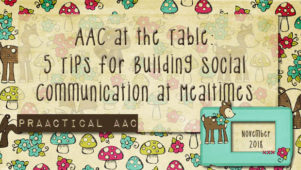
Think back on some of the meals that you’ve shared with others recently. What did people talk about? In most cases, there’s a lot more that ‘Pass the peas,’ ‘What’s for dessert?’, and ‘Can I go now?’ Mealtimes are social experiences in many cultures and it can take some work to ensure that our AAC learners can take part. Here are some ideas for supporting the development of social communication during shared meals. Build a routine that includes social communication: AAC learning takes time and lots of prAACtice. We can support the march to AAC proficiency by incorporating specific kinds of social exchanges into our mealtimes so that AAC learners know what the expect and have practice opportunities for this skill set at mealtime. Some examples: Sharing Time (i.e.., everyone shares something that happened to them that was funny/interesting/memorable), Question of the Day (e.g., “What’s your favorite __?” “Where’s the... [Read More...]
October 15, 2018
by Carole Zangari -
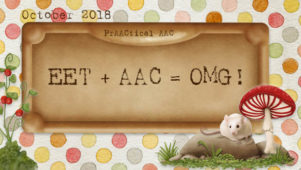
Supporting language development through well-planned intervention is a favorite topic here, and it is with pleasure that we feature Indiana-based SLP and ATP, Beth Waite-Lafever. Beth is a speech-language pathologist and has RESNA certification in Assistive Technology. She has worked in the field of AAC over the past 30 years in outpatient rehab, private practice, and public schools. Beth is a frequent presenter at national conferences, including ATIA and Closing The Gap, and teaches monthly online courses in implementation and use of speech generating devices. Currently, she is an SLP and Assistive Technology Coach for MSD Martinsville, a school district 30 miles south of Indianapolis and maintains a private practice. In this post, Beth shares her experiences in using the Expanding Expression Tool in language therapy with students who use AAC. ::::::::::::::::::::::::::::::::::::::::::::::::::::::::::::::::::::::::::::::::::::::::::::::::::::::::: EET + AAC = OMG! You may have heard of EET; Expanding Expression Tool, a multi-sensory strategy designed by speech-language... [Read More...]
October 12, 2018
by Carole Zangari -
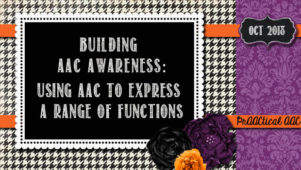
Most times, the goal of AAC intervention is to help those with complex communication needs be able to express whatever they want at any time. For some individuals, we over-emphasize the tools and strategies they will need to get the things they want, whether it is social engagement (attention), assistance (help), objects, events, or even being able to protest or reject unwanted situations. Michigan-based SLP Rachael Langley works tirelessly to support technologies and services that give access to the full range to communicative functions. When she offered to share her thoughts on this topic with us, we jumped on the chance. Enjoy! :::::::::::::::::::::::::::::::::::::::::::::::::::::::::::::::::::::::::::::::::::::::::::::::::::::::::::::::::::::::::::::::::::::::::::::::::: Four Functions of Language There are many ways to emphasize AAC use and embed aided language into the day. Sometimes we use a core vocabulary approach to teach specific vocabulary. But we can also approach AAC learning by focusing on a specific function or pragmatic use of language.... [Read More...]
October 11, 2018
by Carole Zangari -
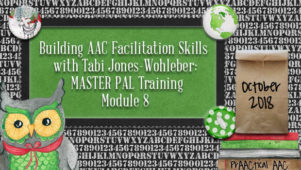
Our AAC Training Series continues today and we remain extremely appreciative that West Virginia based SLP Tabi Jones-Wohleber allows us to share these presentation materials. Today’s training materials center on a topic that will help AAC interventionists strengthen their relationships with AAC learners and provide important language learning opportunities at the same time. This module, Response NOT Required, is all about interactions that engage our learners and invite them into the conversation. The instructional time for Module 8 is about 20 minutes so this can feasibly be shared in a formal or informal sharing session before or after the school day. ::::::::::::::::::::::::::::::::::::::::::::::::::::::::::::::::::::::::::::::::::::::::::::::::::::::::::::: Model as a MASTER PAL Module 8: Response NOT Required Facilitator Guidelines When I talk about modeling without expectation of a response, I often get quizzical sideways glances. It is not an intuitive way of interacting, especially in an educational environment where responding is inherent in classroom... [Read More...]
September 20, 2018
by Carole Zangari -
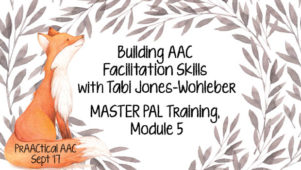
Our AAC Training Series continues today and we are incredibly grateful to Tabi Jones-Wohleber for sharing these presentation materials with us. Today’s training materials center on a topic that is near and dear to my prAACtical heart: Using statements more often than questions. The instructional time for Module 5 is about 90-120 minutes which allows time for discussion and practice. ::::::::::::::::::::::::::::::::::::::::::::::::::::::::::::::::::::::::::::::::::::::::::::::::::::::::::::: Model as a MASTER PAL Module 5: Statements More Than Questions Facilitator Guidelines STATEMENTS MORE THAN QUESTIONS Questions are necessary to help us learn about the things, people, and activities in our environment and beyond. However, interactions heavily weighted with questions do not often yield the quality exchanges required to build relationships, gain understanding, foster autonomous communication or facilitate initiation. This module explores the power of statements (aka nondirective language and descriptive teaching) in shaping meaningful engagement for learning and socially interacting. It includes interactive activities, video links, lots... [Read More...]
April 29, 2018
by Carole Zangari -
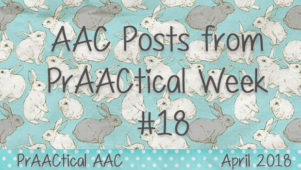
It’s almost time to say goodbye to April and all of the wonderful autism awareness and acceptance activities. Before you head out to your busy week, take a look at some of our past posts. Monday – How I Do It: Building Friendship Skills with Peer-A-Mids Tuesday – AAC Link Up Wednesday – Video of the Week: From Referential to Descriptive Teaching with AAC Learners Thursday – PrAACtically May: AAC Resources for A Year of Core Vocabulary Words Still have time for a little more? Here are a handful of posts to get you started. Vocabulary Activities: 5 Sites for Learning with Avatars PrAACtically Reading with Karen Natoci – The Family Book Using Metaphors to Support Vocabulary Teaching AAC In the High School Classroom – Where Core Vocabulary Meets Life Skills How I Do It: A Year of Core Words in AACtion
January 25, 2018
by Carole Zangari -

Reading together with AAC learners can be a great activity for building engagement, language, and literacy skills. Like any other activity, though, it won’t be very helpful in doing that unless we use effective strategies. Today, we share an online module that will help with the basics of interactive book reading. Part of Project CONNECT, The Center to Mobilize Early Childhood Knowledge, which offers full courses for a fee and a limited set of modules (like the one we are sharing today) at no charge. This is a great starting place for anyone looking to better understand how to use shared reading as a way to build communication skills. From there, we can guide families, paraprofessionals, and professionals who work with AAC learners to utilize additional strategies, such as aided language input and descriptive talking, to support those who use some form of augmentative communication. Enjoy learning more about Dialogic... [Read More...]
January 21, 2018
by Carole Zangari -
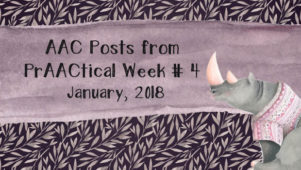
Happy Sunday, AAC friends! Looking for tips to hone your AAC therapy and instruction? We shaerd quite a few on the blog this week. Monday – 10 Tips for Starting AAC Therapy with Little Ones Wednesday – Video of the Week: Supporting Emergent AAC Learners in Inclusive Education Through Descriptive Teaching Thursday – Building Linguistic Competence in AAC Learners: 3 Areas to Consider Targeting And if you are thirsty for more, check out some past posts on activities and materials for AAC therapy and instruction. Magic Moments with Verb Circus PrAACtical Ways to Make Decisions about Thematic Therapy Materials Why We Love AAC Language Experience Activities Vocabulary Activities: 5 Sites About Learning with Avatars AAC Intervention: 5 Activities with PrAACtical Potential
January 18, 2018
by Carole Zangari -
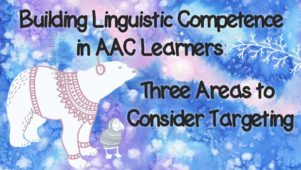
For several years, those who specialize in supporting AAC learners have stressed the need to develop AAC systems and programming that go beyond the communicative function of requesting in order to target the ability to protest, reject, comment, etc. This has been an important trend that will empower users of AAC to express themselves in much fuller ways. What other things should we be targeting in order to help our clients and students become more linguistically competent? Here are some ideas for goal areas to consider. Temporal Markers: While no one can overstate the importance of talking about our current needs, interests, observations, and preferences, we have to be careful not to get stuck in the moment. It is also important for our AAC learners to develop the language skills to be able to talk about things that already happened or that will/might be happening. Why? Among other things, this... [Read More...]









